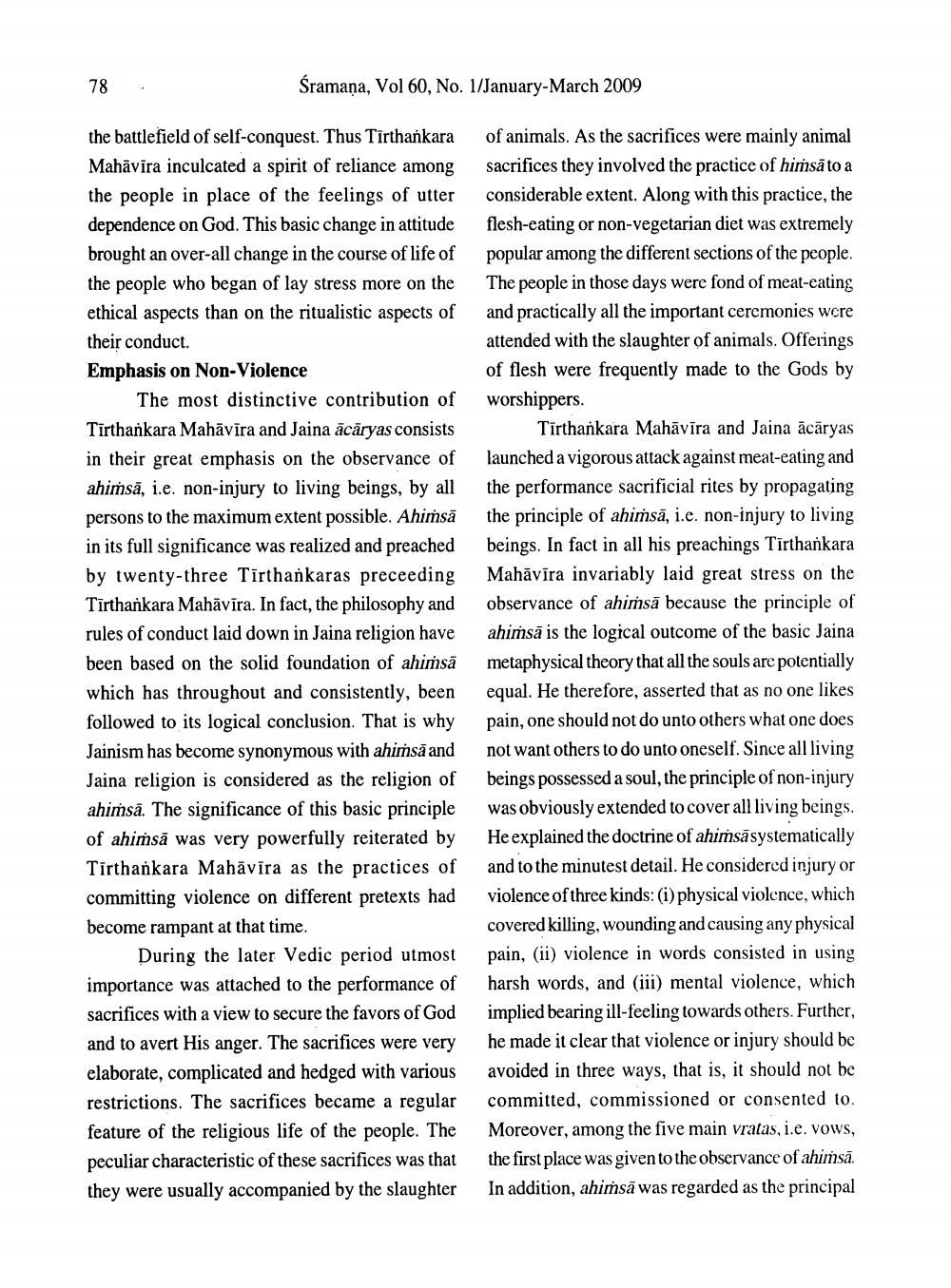________________
78
.
Śramaņa, Vol 60, No. 1/January-March 2009
the battlefield of self-conquest. Thus Tīrthankara Mahāvīra inculcated a spirit of reliance among the people in place of the feelings of utter dependence on God. This basic change in attitude brought an over-all change in the course of life of the people who began of lay stress more on the ethical aspects than on the ritualistic aspects of their conduct. Emphasis on Non-Violence
The most distinctive contribution of Tīrthankara Mahāvīra and Jaina ācāryas consists in their great emphasis on the observance of ahiṁsā, i.e. non-injury to living beings, by all persons to the maximum extent possible. Ahimsā in its full significance was realized and preached by twenty-three Tīrthankaras preceeding Tīrthankara Mahāvīra. In fact, the philosophy and rules of conduct laid down in Jaina religion have been based on the solid foundation of ahimsā which has throughout and consistently, been followed to its logical conclusion. That is why Jainism has become synonymous with ahimsā and Jaina religion is considered as the religion of ahiṁsā. The significance of this basic principle of ahimsā was very powerfully reiterated by Tirthankara Mahāvīra as the practices of committing violence on different pretexts had become rampant at that time.
During the later Vedic period utmost importance was attached to the performance of sacrifices with a view to secure the favors of God and to avert His anger. The sacrifices were very elaborate, complicated and hedged with various restrictions. The sacrifices became a regular feature of the religious life of the people. The peculiar characteristic of these sacrifices was that they were usually accompanied by the slaughter
of animals. As the sacrifices were mainly animal sacrifices they involved the practice of himsāto a considerable extent. Along with this practice, the flesh-eating or non-vegetarian diet was extremely popular among the different sections of the people. The people in those days were fond of meat-eating and practically all the important ceremonies were attended with the slaughter of animals. Offerings of flesh were frequently made to the Gods by worshippers.
Tīrthankara Mahāvīra and Jaina ācāryas launched a vigorous attack against meat-eating and the performance sacrificial rites by propagating the principle of ahimsā, i.e. non-injury to living beings. In fact in all his preachings Tīrthankara Mahāvīra invariably laid great stress on the observance of ahiṁsā because the principle of ahiṁsā is the logical outcome of the basic Jaina metaphysical theory that all the souls are potentially equal. He therefore, asserted that as no one likes pain, one should not do unto others what one does not want others to do unto oneself. Since all living beings possessed a soul, the principle of non-injury was obviously extended to cover all living beings. He explained the doctrine of ahimsāsystematically and to the minutest detail. He considered injury or violence of three kinds: (i) physical violence, which covered killing, wounding and causing any physical pain, (ii) violence in words consisted in using harsh words, and (iii) mental violence, which implied bearing ill-feeling towards others. Further, he made it clear that violence or injury should be avoided in three ways, that is, it should not be committed, commissioned or consented to. Moreover, among the five main vratas, i.e. vows, the first place was given to the observance of ahimsā. In addition, ahiṁsā was regarded as the principal




